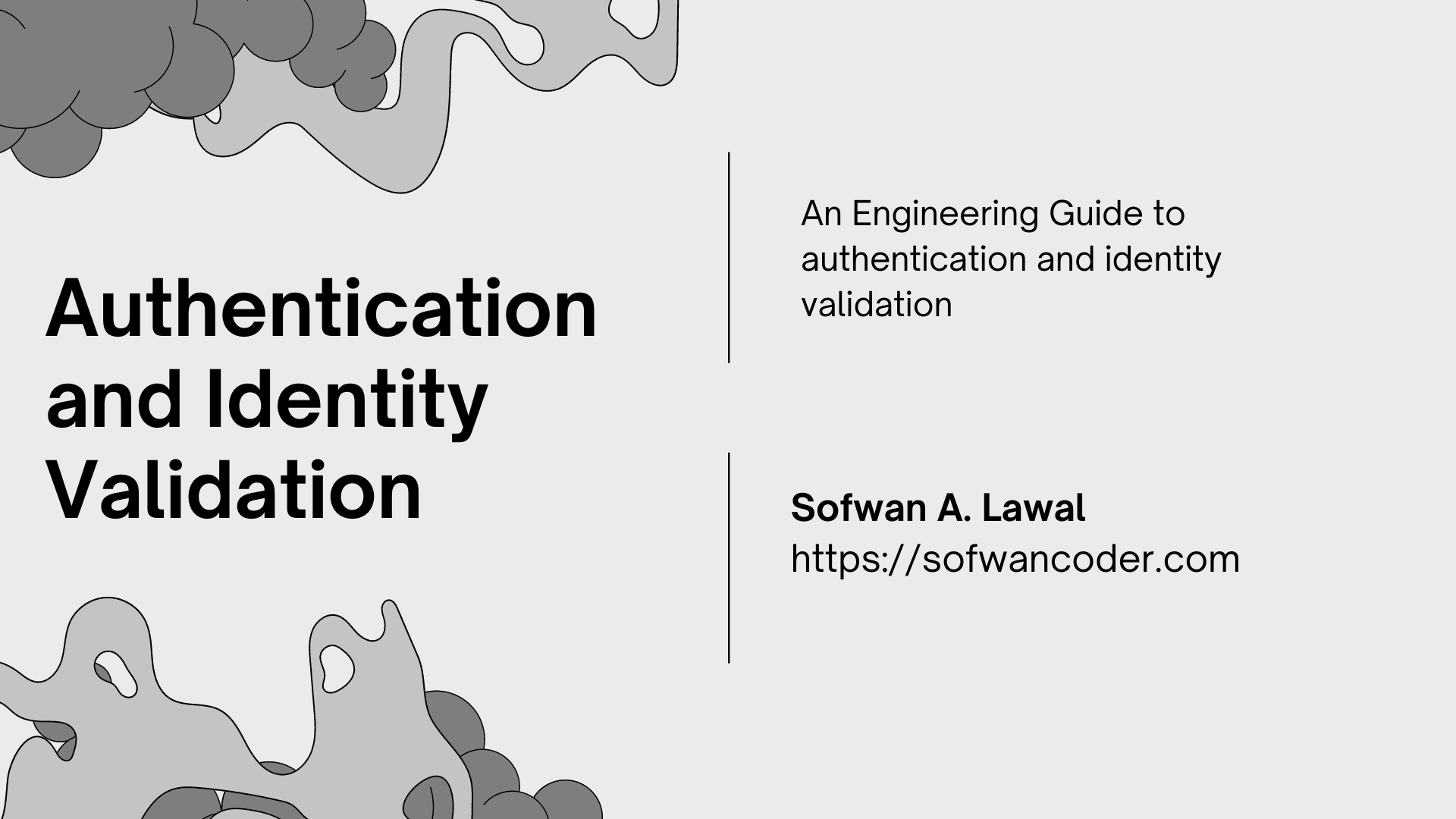Authentication and Identity Validation
 Sofwan A. Lawal
Sofwan A. Lawal
Authentication and identity validation are important concepts in software engineering, as they ensure that only authorized users have access to certain resources or systems. In this article, we will explore the basics of authentication and identity validation, and discuss some best practices for implementing these security measures.
Introduction
When you log into your bank, social media account, or email, you are usually prompted to provide some sort of verification such as a password or a secret answer. This is known as “authentication”.
When you are building an authentication system from scratch, you need identity validation as part of your user onboarding process. With identity validation, we can check what information about the user is publicly available and how trustworthy those sources are.
For this article, I've consulted a DevRel expert from IdentityPass—a company that offers a suite of products to help you verify and gain deeper insights about your customers/business to stay compliant and avoid fraudulent activities— for tips to consider when dealing with Identity-aware systems.
What is Authentication?
Authentication is the process of verifying the identity of a user, device, or system. It is typically done through the use of credentials, such as a username and password, biometric data, or a token. When you log into a website, app or other digital service, you are authenticating yourself with that service.
Users prove their identity to a system via the process of Authentication. When you log into your email account, you prove that you are the owner of that account by entering your password.
Types of Authentication
The goal of authentication is to confirm that the user or device attempting to access a system or resource is who or what they claim to be. There are several types of authentication methods, including:
Knowledge-based authentication: What you know
This type of authentication relies on the user being able to provide a piece of information that only they should know, such as a password or a personal identification number (PIN).
Possession-based authentication: What you have
This type of authentication requires the user to present a physical object that they possess, such as a security token or a smart card.
Inherence-based authentication: What you are
This type of authentication uses biometric data, such as fingerprints, facial recognition, or voice recognition, to verify the identity of the user.
What is Identity Validation?
Identity validation is the process of confirming that an individual is who they claim to be. It is the process of confirming that a person attempting to sign up for a service or log into an existing account is who they claim to be. It involves verifying that the information provided by a user is accurate and corresponds to a real person. This can also involve verifying the user's name, date of birth, address, and other personal details.
There are several methods for identity validation, including:
Manual verification: This involves manually reviewing the information provided by the user and comparing it to other sources, such as government records or credit bureau data.
Automated verification: This involves using software or other automated systems to verify the information provided by the user. This can include using algorithms to check for inconsistencies or red flags or using external sources—such as IdentityPass— to confirm the accuracy of the information.
When you create an account on Uber or Lyft, you authenticate yourself through your account by entering your email and password. But when you first use the account, you are asked to confirm your identity by adding a photo of your license. You are validating that you are who you say you are. Identity validation is often used in situations where sensitive information is being shared, like when applying for a loan or setting up a health insurance account. It is also used in business settings for compliance reasons, such as in financial services where certain types of accounts require an “accepted” or “verified” ID.
Why is Identity Validation Important?
Identity validation is important for several reasons:
Security: By verifying the identity of users, organizations can ensure that only authorized individuals have access to sensitive information and systems. This helps to prevent unauthorized access, data breaches, and other security incidents.
Compliance: Many industries and organizations are subject to regulations that require them to verify the identity of individuals. For example, financial institutions are required to comply with anti-money laundering (AML) and know-your-customer (KYC) regulations, which mandate the verification of customer identities.
Fraud prevention: By validating the identity of users, organizations can detect and prevent fraudulent activity. For example, by verifying that the information provided by a user corresponds to a real person, organizations can prevent individuals from creating fake accounts or using stolen identities.
Trust and credibility: By validating the identity of users, organizations can build trust and credibility with their customers. This can be especially important for businesses that rely on online transactions, where customers may be hesitant to provide personal information without assurance that it will be protected.
Accurate record-keeping: Identity validation also helps organizations to maintain accurate and up-to-date records of their customers and clients. This can help organizations comply with regulations and laws that require the maintenance of accurate records and can be useful for future reference.
Overall, identity validation is an important aspect of security and compliance that helps organizations to protect their assets and customers, prevent fraud, and maintain trust and credibility. Organizations must have well-defined and implemented procedures for identity validation that are compliant with industry and legal standards.
Authenticate! identify!! Verify!!!
Yes! Exactly in that order. Let your users tell you who they are, attempt to identify them, and finally verify that they are exactly everything they claim to be.
Authentication is the process of proving that you are who you say you are by entering a password, name or other identifiers. You log into an account or website by authenticating yourself. You can also authenticate someone else by logging into their account and entering the correct password or other identifiers.
Identification is the process of confirming that you are who you say you are. You can identify yourself by providing personal details like your name, date of birth or address.
Verification is the process of confirming that something is true. Similarly, you can verify an account by providing an identifying feature like your mother’s maiden name or your National Identification Number.
Should you implement identity validation?
If you are storing sensitive information like National Identification Numbers, you may be required to implement identity validation. Additionally, some industries, like financial services, demand that businesses meet strict identity validation requirements. Other industries, like healthcare, also often require identity validation. Before implementing identity validation, make sure you understand the requirements in your industry.
It is important to note that not all identity verification providers are created equal. Selecting a provider that offers the features required for your business, including robust fraud prevention and reliable results, is critical. A very good example is IdentityPass which offers a wide range of solutions to help businesses with many possible identity and business verification needs.
Best Practices for Implementing Identity Validation
Collect only what is necessary: Review your data requirements and make sure they are necessary and relevant to your business. The fewer verifications you require, the less friction there is in the sign-up process.
Build flexibility into your requirements to reduce false negatives: False negatives occur when someone fails to pass a verification check and is unable to sign up for an account. These can cause major problems for your business.
Make it easy for users to verify their information: Offer multiple verification methods, and make sure you are guiding users through the process and helping them along the way.
Use identity validation early in the onboarding process: By validating the user’s identity at the beginning of the onboarding process, you can significantly reduce false negatives and decrease the complexity of your sign-up and onboarding process.
Use encrypted communication: When transmitting authentication credentials or other sensitive information, it's important to use encrypted communication to prevent interception by attackers.
Implement identity validation measures: To ensure that the information provided by users is accurate and corresponds to real people, it's important to implement identity validation measures, such as manual or automated verification processes.
Conclusion
Authentication is the process by which a user proves their identity to a system, while identity validation is the process of confirming that a person attempting to sign up for a service or log into an existing account is who they claim to be.
Subscribe to my newsletter
Read articles from Sofwan A. Lawal directly inside your inbox. Subscribe to the newsletter, and don't miss out.
Written by

Sofwan A. Lawal
Sofwan A. Lawal
I am a seasoned Software Engineer with over 8 years of diverse experience, primarily focusing on Backend Software Engineering and Complex systems.